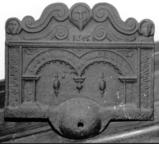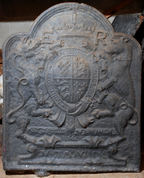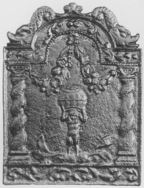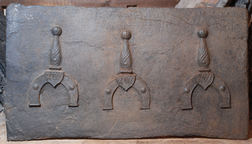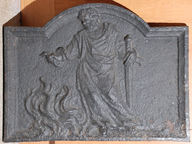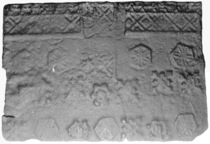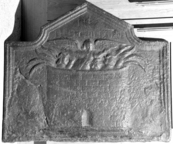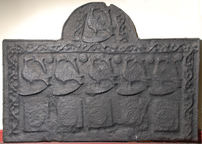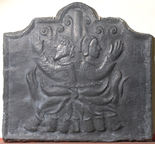-
812
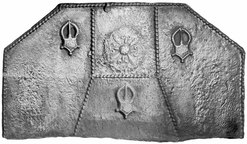 ? x ? mm
? x ? mmDescription: Canted rectangle; twisted rope edging (top and sides); divided by rope lengths into four panels: centre top, square; centre bottom, trapezium; sides, irregular hexagons; buckle stamp repeated three times, in bottom and side panels; top centre panel, circular flower stamp with fleur de lys on each petal.
Notes: The buckle stamps suggest a connection with the Pelham family; illustrated in Butterfield 1916, where it was stated to have been in a house at Herstmonceux, Sussex..
- Decoration tags:
- rectangular with canted top corners (shape)
- rope (edging)
- simple stamps
- carved stamps
- planklines
- heraldic
- objects
Manufactured: in the late-16th century in the Weald area of England.
Current location: not known.
Citation: Butterfield, W. R., 1916, 'Old Wealden Firebacks', The Connoisseur, 46, pp. 197-209.
- Attached to series:
- Pelham family firebacks
- Metalware stamp firebacks
-
123
Description: Rectangular; top panel with bearded face between symmetrical horizontal scrolls, and faces at either end; scrolls are repeated below, on either side of the date, all above a horizontal double fillet; below, a pair of arches with guilloche decoration between fillets, and toothed on the underside, are supported on each side by Tuscan columns, also with guilloche decoration; this is repeated in symmetrical rectangular panels on either side; at the centre base a bulbous nozzle protrudes.
Notes: This is a smith's forge fireback, the nozzle being the tuyere directing the air into the fire from bellows behind. Stylistically similar to the Lenard and other firebacks of the same period, the carved elements above the nozzle may have been cast from a pattern inspired by the back of a joined 'wainscot' chair, with the date inserted. The back may have been used for forging non-ferrous metals as there was a trade in pot-founding in bronze as well as iron at some ironworks in the Weald. Formerly part of the Ade Collection (from Grove Hill, Hellingly, Sussex).
Inscription: 1655
- Decoration tags:
- rectangular with round arch (shape)
- fillet (edging)
- whole carved pattern
- individual numbers
- architectural
- text
- humans
Manufactured: in 1655 in the Weald area of England.
Current location: Hastings Museum and Art Gallery, John's Place, Bohemia Road, Hastings, East Sussex, England.
Museum number: HASMG: 1952.51.62 (part of the Hastings Museum museum group)
Citation: Butterfield, W. R., 1916, 'Old Wealden Firebacks', The Connoisseur, 46, pp. 197-209.
- Attached to series:
- Chair pattern firebacks
- Furniture stamp firebacks
-
147
Description: Arched rectangular shape with rounded corners; ovolo within fillet moulding all round; oval Tudor royal shield with garter surrounding, topped with a royal crown; dragon and greyhound supporters; initials split by crown; inscription on a fillet between legs of supporters, behind garter finial; motto on an Ionic plinth at bottom.
Notes: The supporters are those of Henry VII or Henry VIII, but the initials suggest the fireback dates from the reign of Edward VI (1547-53). John Harvo (d. c1565) was a gunfounder who has been identified as occupying Pounsley furnace, Framfield, Sussex, possibly from as early as 1547. This fireback is also seen with a variety of rectangular, rope-edged side panels bearing stamps or letters, some of which link the source of this and other groups of firebacks. The pattern or model for this fireback may have been made during the reign of Henry VIII (1509-47), with the initials added to an early casting using the original pattern. The protuberance on the bottom of the plate may be the remains of the runner from a pouring basin or overflow channel used during casting. Formerly part of the Ade Collection (from Grove Hill, Hellingly, Sussex).
Copies of this fireback are known.
Inscription: E R / HONY SOYT QVE MAL Y PAVNCE / Made in Sussex by John Harvo / DV ET MOVN DRO
Arms: Tudor royal (Edward VI)
- Decoration tags:
- rectangular with round arch (shape)
- fillet and cavetto (edging)
- whole carved pattern
- individual letters
- armorial
- text
Manufactured: in the mid-16th century probably at Pounsley Furnace, Framfield in the Weald area of England.
Current location: Hastings Museum and Art Gallery, John's Place, Bohemia Road, Hastings, East Sussex, England.
Museum number: HASMG: 1952.51.52 (part of the Hastings Museum museum group)
Citation: Butterfield, W. R., 1916, 'Old Wealden Firebacks', The Connoisseur, 46, pp. 197-209.
-
160
Description: Arched rectangular shaped panel with fillet edging; two Salomonic columns supporting a beaded arch; standing figure of Atlas supporting a globe, on ground with plants, and two swags of fruit and leaves suspended from the centre of the arch to the capitals of the columns; above the beaded arch, symmetrical swirls of fruit and foliage; on top, a scallop shell between two sea serpents.
Notes: Probably an English design copying the north German 'Dutch' style.
Copies of this fireback are known.
- Decoration tags:
- 'Dutch' (shape)
- fillet (edging)
- whole carved pattern
- mythological
- architectural
- humans
- plants
- objects
Manufactured: in the late-17th to early-18th century in England.
Current location: Hastings Museum and Art Gallery, John's Place, Bohemia Road, Hastings, East Sussex, England.
Museum number: HASMG: 1917.196.6 (part of the Hastings Museum museum group)
Citation: Butterfield, W. R., 1916, 'Old Wealden Firebacks', The Connoisseur, 46, pp. 197-209.
Citation: Lloyd, N., 1925, 'Domestic Ironwork I', Architectural Review, 58, pp. 58-67.
Citation: Baines, J. M., 1958, Wealden Firebacks (Hastings Museum).
- Attached to series:
- British 'Dutch' style firebacks
-
166
Description: Rectangular; plain plate with three stamps of an iron firedog with a twisted design on the neck, a primitive face on the terminal and a shield bearing initials RW.
Notes: The letters RW are said to relate to Richard Woodman, ironmaster and Protestant martyr, who resided at Cralle Place, and who operated Cralle furnace. A near-identical firedog was discovered at Bridge Cottage, Uckfield, Sussex.
Inscription: RW
- Decoration tags:
- rectangular (shape)
- none (edging)
- simple stamps
- objects
Manufactured: in the mid-16th century probably at Cralle Furnace, Warbleton in the Weald area of England.
Current location: Hastings Museum and Art Gallery, John's Place, Bohemia Road, Hastings, East Sussex, England.
Museum number: HASMG: 1909.94 (part of the Hastings Museum museum group)
Citation: Butterfield, W. R., 1916, 'Old Wealden Firebacks', The Connoisseur, 46, pp. 197-209.
- Attached to series:
- Firedog stamp firebacks
- Metalware stamp firebacks
-
162
Description: Arched rectangular shaped; cavetto-moulded edge; figure of St Paul, a sword in his left hand, holding a viper in his right hand over flames rising from the ground.
Notes: The scene illustrates an episode in the New Testament, Acts 28: 3. The design shows stylistic similarities to other firebacks where simple, well-executed relief has overlapped the cavetto edging. Formerly part of the Ade Collection (from Grove Hill, Hellingly, Sussex).
Copies of this fireback are known.
- Decoration tags:
- rectangular with round arch (shape)
- cavetto (edging)
- whole carved pattern
- pictorial
- biblical
- humans
Manufactured: in the mid- to late-17th century possibly in the Weald area of England.
Current location: Hastings Museum and Art Gallery, John's Place, Bohemia Road, Hastings, East Sussex, England.
Museum number: HASMG: 1952.51.25 (part of the Hastings Museum museum group)
Citation: Butterfield, W. R., 1916, 'Old Wealden Firebacks', The Connoisseur, 46, pp. 197-209.
- Attached to series:
- Small cavetto series
- New Testament firebacks
-
152
Description: Rectangular; plain plate; on top, twice repeated stamp probably formed of a section of cresting with a row of seven ?fleurs-de-lys above a diagonal grid of squares, each with a small raised square in the middle, and a horizontal astragal border below; between the cresting, a stamp of indeterminate form and design; below, four repeated hexagonal stamps, each divided into triangles by raised lines, two under each cresting stamp; between them, a stamp of indeterminate form and design, possibly the same as the one above it; below, probably six double crosses flory, with a flower head stamp between each group of three; along the bottom, two crosses flory, three hexagon stamps and two other stamps of indeterminate form and design (though different from those described above), arranged asymetrically.
Notes: A crude and poorly executed casting. Butterfield (1916) illustrated this fireback the other way up, and that is how it was displayed in Hastings Museum when it was photographed in the early 2000s. The orientation of this fireback has been reconsidered and the greater relative wear and heat corrosion of the smaller individual stamps suggests that the cresting was originally at the top of the fireback and not the bottom.
- Decoration tags:
- rectangular (shape)
- none (edging)
- carved stamps
- objects
Manufactured: in the mid-16th century in the Weald area of England.
Current location: Hastings Museum and Art Gallery, John's Place, Bohemia Road, Hastings, East Sussex, England.
Museum number: HASMG: 1911.60.8 (part of the Hastings Museum museum group)
Citation: Butterfield, W. R., 1916, 'Old Wealden Firebacks', The Connoisseur, 46, pp. 197-209.
- Attached to series:
- Miscellaneous stamp firebacks
-
159
Description: Rectangular with ‘pediment’ arch linked by cavetto curves; fillet and cavetto edging; pictorial, a cylindrical furnace with inscribed stone courses, flames issuing from the top, with the heads of three people, a hand raised from two of them, and an angel with wings and arms outstretched; the furnace has a small arched opening bottom centre; above the angel, the inscription was inscribed on the pattern.
Notes: The scene represents Shadrach, Meshach, and Abednego being delivered from the burning fiery furnace by the angel of God (Daniel 3), the phrase, The Three Children, being a reference to the eponymous apocryphal verses from the Book of Daniel. Formerly at Brightling Hall, Robertsbridge, Sussex.
Inscription: THE THREE CHILDREN
- Decoration tags:
- rectangular with pediment (shape)
- cavetto (edging)
- whole carved pattern
- pictorial
- biblical
- architectural
- text
- humans
- objects
Manufactured: in the early- to mid-17th century possibly in the Weald area of England.
Current location: Hastings Museum and Art Gallery, John's Place, Bohemia Road, Hastings, East Sussex, England.
Museum number: HASMG: 1913.58 (part of the Hastings Museum museum group)
Citation: Baines, J. M., 1958, Wealden Firebacks (Hastings Museum).
Citation: Butterfield, W. R., 1916, 'Old Wealden Firebacks', The Connoisseur, 46, pp. 197-209.
Citation: Butterfield, W. R., 23 Feb 1935, 'A Scriptural Fireback', Hastings and St Leonards Observer.
- Attached to series:
- Old Testament & Apocrypha firebacks
-
383
Description: Arched rectangular shape; thin twisted rope edging on top and sides; trailing vine strips frame a row of repeated bird (probably swan) stamps (5) above repeated rose en soleil stamps (5); single bird stamp with two short, slanting vine strips in top arch.
Notes: The rose-en-soleil was the badge of King Edward IV and, thus, a Yorkist symbol, while the swan had been adopted by Henry IV and was, therefore, a Lancastrian symbol.
- Decoration tags:
- rectangular with round arch (shape)
- rope (edging)
- simple stamps
- carved stamps
- heraldic
- objects
Manufactured: in the mid- to late-16th century possibly at Pounsley Furnace, Framfield in the Weald area of England.
Current location: Anne of Cleves House, Southover High Street, Lewes, East Sussex, England.
Museum number: LH000.941 (part of the Sussex Archaeological Society museum group)
Citation: Butterfield, W. R., 1916, 'Old Wealden Firebacks', The Connoisseur, 46, pp. 197-209.
-
396
Description: Cavetto-canted rectangle with arched top; astragal and cavetto edging (top and sides); pictorial; back-to-back figures of a bearded man and a woman in a poke bonnet, both dressed in tunics, their arms raised, respectively left and right; they are chained to a vertical pole; below, flames issue from vertically stacked logs, while smoke rises above them; the physical proportions of the figures are naïve, the man’s eyes being over-large, as are the hands of both.
Notes: The design is a free adaptation of an illustration from The Book of Martyrs by John Foxe (1563), a copy from a back originally noted at Brick Cottage, Burwash, Sussex, in 1871. This may be the design of fireback referred to in an enquiry printed in the St James's Chronicle, or British Evening Post, of 9 August 1788, which described it as 'having two Bishops burning at Stakes thereon' at a house in Warwickshire. At an auction sale in 2017 the same design of fireback was interpreted as the burning of Bishops Latimer and Ridley in 1555. Protestants were burnt to death at several Wealden locations as well as elsewhere in the south-east of England during the reign of Mary I, notably at Canterbury and Lewes. The subject of the fireback should be regarded as symbolic rather than commemorating any individual martyrs.
Copies of this fireback are known.
- Decoration tags:
- rectangular with canted top corners and round arch (shape)
- astragal with cavetto (edging)
- whole carved pattern
- pictorial
- historical
- humans
Manufactured: in the late-16th to early-17th century in the Weald area of England.
Current location: Anne of Cleves House, Southover High Street, Lewes, East Sussex, England.
Museum number: LH000.903 (part of the Sussex Archaeological Society museum group)
Citation: Butterfield, W. R., 1916, 'Old Wealden Firebacks', The Connoisseur, 46, pp. 197-209.
Citation: Dawson, C., 1903, 'Sussex Iron Work and Pottery', Sussex Archaeological Collections, 46, pp. 1-54.
Citation: Paine, C., Aug 2013, 'Mystery of the Two Martyrs', Sussex Past and Present, 130, pp. 6-7.
Citation: Straker, E., 1931, Wealden Iron (London, Bell).
- Attached to series:
- Commemorative firebacks
